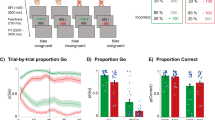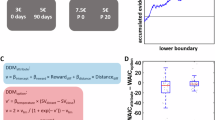Abstract
Acute phenylalanine/tyrosine depletion (ATPD) has been used to transiently lower central nervous system dopamine activity in animals and humans. Findings suggest that ATPD may impact dopamine transmission in limbic and striatal regions. Impact on cognitive functions has varied across studies, although several recent reports suggest that affective processing in the context of a go/no-go response control task may be impaired during ATPD. In this study, response control under affective vs nonaffective conditions was examined in healthy individuals who underwent either ATPD or a balanced condition in a between-subjects design. Effects of ATPD were validated through its effects on serum prolactin secretion. ATPD resulted in significantly increased prolactin levels relative to the balanced mixture. Although there were no differences in self-reported mood between the groups, individuals in the ATPD condition demonstrated diminished sensitivity to positively valenced words and seemingly enhanced sensitivity to negatively valenced words in an affective go/no-go task. They also showed difficulties in modulating ongoing behavior in a nonaffective go/no-go task when responses had to be intermittently inhibited then immediately restarted. Basic motor functions were not impacted. Findings are discussed in relation to dopamine's role in switching signals within neural networks that are important for response modulation and affective control.
Similar content being viewed by others
Log in or create a free account to read this content
Gain free access to this article, as well as selected content from this journal and more on nature.com
or
References
Benton AL, Hamsher KD (1976). Multilingual Aphasia Examination. University of Iowa: Iowa City.
Boado RJ, Li JY, Nagaya M, Zhang C, Pardridge WM (1999). Selective expression of the large neutral amino acid transporter at the blood–brain barrier. Proc Natl Acad Sci USA 96: 12079–12084.
Bond A, Lader M (1974). The use of analogue scales in rating subjective feelings. Br J Med Psychol 47: 211–218.
Bradley MM, Lang PJ (1999). Affective Norms for English Words (ANEW). The NIMH Center for the Study of Emotion and Attention, University of Florida: Gainesville, FL.
Braver TS, Barch DM, Gray JR, Molfese DL, Snyder A (2001). Anterior cingulate cortex and response conflict: effects of frequency, inhibition and errors. Cerebral Cortex 11: 825–836.
Carver CS, White TL (1994). Behavioral inhibition, behavioral activation, and affective responses to impending reward and punishment: the BIS/BAS scales. J Pers Soc Psychol 67: 319–333.
Cools R, Barker RA, Sahakian BJ, Robbins TW (2001). Enhanced or impaired cognitive function in Parkinson's disease as a function of dopaminergic medication and task demands. Cerebral Cortex 11: 1136–1143.
Cools R, Barker RA, Sahakian BJ, Robbins TW (2003). l-Dopa medication remediates cognitive inflexibility, but increases impulsivity in patients with Parkinson's disease. Neuropsychologia 41: 1431–1441.
Depue RA, Iacono WG (1989). Neurobehavioral aspects of affective disorders. Ann Rev Psychol 40: 457–492.
Ellenbogen MA, Young SN, Dean P, Palmour RM, Benkelfat C (1996). Mood response to acute tryptophan depletion in healthy volunteers: seex differences and temporal stability. Neuropsychopharmacology 15: 465–474.
Fernstrom M, Fernstrom J (1995). Acute tyrosine depletion reduces tyrosine hydroxylation rate in rat central nervous system. Life Sci 57: 97–102.
First MB, Spitzer RL, Gibbon M, Williams JBW (1997). Structured Clinical Interview for DSM-IV Axis I Disorders—Patient Edition (SCID-I/P, Version 2.0, 4.97 Revision). New York State Psychiatric Institute, Biometrics Research Department: New York.
Freeman ME, Kanyicska B, Lerant A, Nagy G (2000). Prolactin: structure, function, and regulation of secretion. Physiol Rev 80: 1523–1631.
Harmer CJ, Hill SA, Taylor MJ, Cowen PJ, Goodwin GM (2003). Toward a neuropsychological theory of antidepressant drug action: increase in positive emotional bias after potentiation of norepinephrine activity. Am J Psychiatry 160: 990–992.
Harmer CJ, McTavish SF, Clark L, Goodwin GM, Cowen PJ (2001). Tyrosine depletion attenuates dopamine function in healthy volunteers. Psychopharmacology 154: 105–111.
Harrison BJ, Olver JS, Norman TR, Burrows GD, Wesnes KA, Nathan PJ (2004). Selective effects of acute serotonin and catecholamine depletion on memory in healthy women. J Psychopharmacol 18: 32–40.
Hayes AE, Davidson MC, Keele SW, Rafal RD (1998). Towards a functional analysis of the basal ganglia. J Cogn Neurosci 10: 178–198.
Jaskiw GE, Bongiovanni R (2004). Brain tyrosine depletion attenuates haloperidol-induced striatal dopamine release in vivo and augments haloperidol-induced catalepsy in the rat. Psychopharmacology 172: 100–107.
Knutson B, Wolkowitz OM, Cole SW, Chan T, Moore EA, Johnson RC et al (1998). Selective alteration of personality and social behavior by serotonergic intervention. Am J Psychiatry 155: 373–379.
Le Masurier M, Cowen PJ, Sharp T (2004b). Fos immunocytochemical studies on the neuroanatomical sites of action of acute tyrosine depletion in the rat brain. Psychopharmacology 171: 435–440.
Le Masurier M, Houston G, Cowen PJ, Grasby PM, Sharp T, Hume S (2004a). Tyrosine-free amino acid mixture attenuates amphetamine-induced displacement of [11C]Raclopride in striatum in vivo: a rat PET study. Synapse 51: 151–157.
Leyton M, Dagher A, Boileau I, Casey K, Baker GB, Diksic M et al (2004). Decreasing amphetamine-induced dopamine release by acute phenylalanine/tyrosine depletion: a PET/[11C]raclopride study in healthy men. Neuropsychopharmacology 29: 427–432.
Leyton M, Young SN, Pihl RO, Etezadi S, Lauze C, Blier P et al (1999). Effects on mood of acute phenylalanine/tyrosine depletion in healthy women. Neuropsychopharmacology 22: 52–63.
Lorr M, McNair DM, Fisher S (1982). Evidence for bipolar mood states. J Pers Assess 46: 432–436.
Lorr M, McNair DM, Heuchert JWP (2003). Manual Supplement for the Profile of Mood States: Bipolar Form. Mutli-Health Systems: Toronto.
Luciana M, Collins P (1997). Dopaminergic modulation of working memory for spatial but not object cues in normal humans. J Cogn Neurosci 9: 330–367.
Luciana M, Vrshek-Schallhorn S, Wahlstrom D, White T (2005). Acute tyrosine depletion and dopamine-modulated cognitive functions in healthy volunteers. Paper presented at the Cognitive Neuroscience Society, New York, NY.
Lythe KE, Anderson IM, Deakin JFW, Elliott R, Strickland PL (2005). Lack of behavioral effects after acute tyrosine depletion in healthy volunteers. J Psychopharmacol 19: 5–11.
McLean A, Rubinstein JS, Robbins TW, Sahakian BJ (2004). The effects of tyrosine depletion in normal healthy volunteers: implications for unipolar depression. Psychopharmacology 171: 286–297.
McTavish SF, Callado L, Cowen PJ, Sharp T (1999b). Comparison of the effects of a-methyl-p-tyrosine and a tyrosine-free amino acid load on extracellular noradrenaline in the rat hippocampus in vivo. J Psychopharmacol 13: 379–384.
McTavish SF, Cowen PJ, Sharp T (1999a). Effects of a tyrosine-free amino acid mixture on regional brain synthesis and release. Psychopharmacology 141: 182–188.
McTavish SF, Mannie Z, Cowen PJ (2004). Tyrosine depletion does not cause depressive relapse in antidepressant-treated patients. Psychopharmacology 175: 124–126.
McTavish SF, Mannie Z, Harmer CJ, Cowen PJ (2005). Lack of effect of tyrosine depletion on mood in recovered depressed women. Neuropsychopharmacology 30: 786–791.
McTavish SF, McPherson MH, Harmer CJ, Clark L, Sharp T, Goodwin GM et al (2001b). Antidopaminergic effects of dietary tyrosine depletion in healthy subjects and patients with manic illness. Br J Psychiatry 179: 356–360.
McTavish SF, Raumann B, Cowen PJ, Sharp T (2001a). Tyrosine depletion attenuates the behavioural stimulant effects of amphetamine and cocaine in rats. Eur J Pharmacol 424: 112–119.
Mehta MA, Swainson R, Ogilvie AD, Sahakian BJ, Robbins TW (2001). Improved short-term spatial meory but impaired reversal learning following the dopamine D2 agonist bromocriptine in human volunteers. Psychopharmacology 159: 10–20.
Moja EA, Lucini V, Benedetti F, Lucca A (1996). Decrease in plasma phenylalanine and tyrosine after phenylalanine-tyrosine free amino acid solutions in man. Life Sci 58: 5389–5395.
Montgomery AJ, McTavish SF, Cowen PJ, Grasby PM (2003). Reduction of brain dopamine concentration with dietary tyrosine plus phenylalanine depletion: an [11C]Raclopride PET study. Am J Psychiatry 160: 1887–1889.
Murphy FC, Sahakian BJ, Rubinstein JS, Michael A, Rogers RD, Robbins TW et al (1999). Emotional bias and inhibitory control processes in mania and depression. Psychol Med 29: 1307–1321.
Oades RD (1985). The role of noradrenaline in tuning and dopamine in switching between signals in the CNS. Neurosci Biobehav Rev 9: 261–282.
Palmour RM, Ervin FR, Baker GB, Young SN (1998). An amino acid mixture deficient in phenylalanine and tyrosine reduces cerebrospinal fluid catecholamine metabolites and alcohol consumption in vervet monkeys. Psychopharmacology 136: 1–7.
Patrick CJ, Curtin JJ, Tellegen A (2002). Development and validation of a brief form of the Multidimensional Personality Questionnaire. Psychol Assessment 14: 150–163.
Reitan RM, Davison LA (1974). Clinical Neuropsychology: Current Status and Applications. Hemisphere: New York.
Roiser JP, McLean A, Ogilvie AD, Blackwell AD, Bamber DJ, Goodyer I et al (2005). The subjective and cognitive effects of acute phenylalanine and tyrosine depletion in patients recovered from depression. Neuropsychopharmacology 30: 775–785.
Sheehan BD, Tharyan P, McTavish SF, Campling GM, Cowen PJ (1996). Use of a dietary manipulation to deplete plasma tyrosine and phenylalanine in healthy subjects. J Psychopharmacol 10: 231–234.
Sohn M-H, Ursu S, Anderson JR, Stenger VA, Carter CS (2000). The role of prefrontal cortex and posterior parietal cortex in task switching. Proc Natl Acad Sci USA 97: 13448–13453.
Stanislaw H, Todorov N (1999). Calculation of signal detection theory measures. Behav Res Methods Instr Comput 31: 137–149.
Tellegen A (1985). Structures of mood and personality and their relevance to assessing anxiety, with an emphasis on self-report. In Tuma AH, Maser JD (eds). Anxiety and the Anxiety Disorders. Lawrence Erlbaum Associates: Hillsdale, NJ, pp 681–706.
Torner L, Moloumby R, Nava G, Aranda J, Clapp C, Neumann ID (2004). In vivo release and gene upregulation of brain prolactin in response to physiological stimuli. Eur J Neurosci 19: 1601–1608.
Watson D, Clark L, Carey G (1988). Positive and negative affectivity and their relation to anxiety and depressive disorders. J Abnormal Psychol 97: 346–353.
Watson D, Clark LA (1994). Manual for the Positive and Negative Affect Schedule—Expanded Form. The University of Iowa: Iowa City.
Watson D, Tellegen A (1985). Towards a consensual structure of mood. Psychol Bull 98: 219–235.
Wechsler D (1997). The Wechsler Adult Intelligence Scale, Third Revision. The Psychological Corporation: San Antonio, TX.
Acknowledgements
This work was supported by a McKnight Land-Grant Professorship awarded to M Luciana, by a University of Minnesota Graduate School Fellowship and a National Science Foundation Graduate Research Fellowship to S Vrshek-Schallhorn, and by Grant M01-RR0400 from the National Center for Research Resources, National Institute of Health awarded to the General Clinical Research Center at the University of Minnesota. Address correspondence to either Monica Luciana (lucia003@umn.edu) or Suzanne Vrshek-Schallhorn (vrsh0001@umn.edu).
Author information
Authors and Affiliations
Corresponding author
Rights and permissions
About this article
Cite this article
Vrshek-Schallhorn, S., Wahlstrom, D., Benolkin, K. et al. Affective Bias and Response Modulation Following Tyrosine Depletion in Healthy Adults. Neuropsychopharmacol 31, 2523–2536 (2006). https://doi.org/10.1038/sj.npp.1301172
Received:
Revised:
Accepted:
Published:
Issue date:
DOI: https://doi.org/10.1038/sj.npp.1301172
Keywords
This article is cited by
-
Dopamine precursor depletion affects performance and confidence judgements when events are timed from an explicit, but not an implicit onset
Scientific Reports (2023)
-
Reliance on habits at the expense of goal-directed control following dopamine precursor depletion
Psychopharmacology (2012)
-
The neuropsychopharmacology of action inhibition: cross-species translation of the stop-signal and go/no-go tasks
Psychopharmacology (2008)



